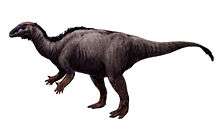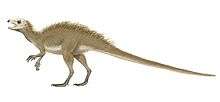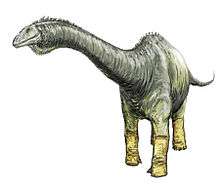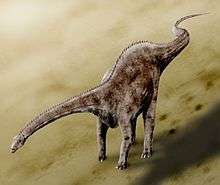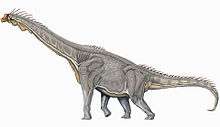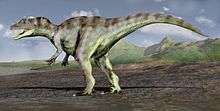List of dinosaurs of the Morrison Formation
The Morrison Formation is a distinctive sequence of Late Jurassic sedimentary rock that is found in the western United States, which has been the most fertile source of dinosaur fossils in North America. It is composed of mudstone, sandstone, siltstone and limestone and is light grey, greenish gray, or red. Most of the fossils occur in the green siltstone beds and lower sandstones, relics of the rivers and floodplains of the Jurassic period.
Fauna comparisons
The fauna of Morrison Formation is similar to one in the coeval rocks of Tendaguru Beds (in Tanzania) and Lourinhã Formation in Portugal,[1] mostly with the second. Some genera are shared in Morrison and Lourinhã, such as Torvosaurus,[2] Ceratosaurus,[3] Stegosaurus, Dryosaurus,[4] and Allosaurus.[5] In sum, Morrison Fm has 47 valid genera of dinosaurs.
Ornithischians
The herbivorous ornithischian dinosaurs were diverse but not as common as sauropods in the Morrison. Fruitadens, previously known as the "Fruita Echinodon", was found to be a heterodontosaurid. Plate-backed stegosaurids included Hesperosaurus mjosi, Stegosaurus armatus, S. ungulatus, S. stenops, and Alcovasaurus longispinus. Armored dinosaurs that weren't stegosaurs were unknown in the formation until the 1990s. Two have been named: Gargoyleosaurus parkpinorum and Mymoorapelta maysi. Ornithopods, bipedal herbivores, came in several types. Small "hypsilophodonts" included Drinker nisti, Laosaurus celer, "L." gracilis, Nanosaurus agilis, Othnielia rex, and Othnielosaurus consors. Larger but similar-looking dryosaurids were represented by Dryosaurus altus and the camptosaurid Uteodon aphanoecetes, which is currently known only from Dinosaur National Monument. Still larger was the more common Camptosaurus dispar. Dryosaurids and camptosaurids were early iguanodonts, a group that would later spawn the duck-billed dinosaurs.
Ornithopods
Color key
|
Notes Uncertain or tentative taxa are in small text; |
| Genus | Species | State | Member | Material | Notes | Images |
|---|---|---|---|---|---|---|
|
Morrison Anomoepus lack the handprint impressions found associated with earlier instances of the ichnogenus in New England.[6] |
| ||||
|
C. amplus[8] |
Now known to be based on a theropod foot.[10] | |||||
|
C. aphanoecetes[11] |
|
|
Reclassified as Uteodon. | |||
|
C. browni[12] |
Junior synonym of C. dispar.[13] | |||||
|
"[Twenty-five to thirty] disarticulated skull elements, some with associated postcrania, approximately [ten] partial, articulated skeletons, juvenile to adult."[18] |
A member of Camptosauridae. Junior synonyms include Camptosaurus browni, C. medius, and C. nanus. | |||||
|
C. medius[12] |
Junior synonym of C. dispar.[13] | |||||
|
C. nanus[12] |
Junior synonym of C. dispar.[13] | |||||
|
|
Multiple Dinehichnus trackways have been discovered. The tracks run parallel to one another, indicating that the trackmaker was at least somewhat of a social animal.[6] |
Dinehichnus are attributed to dryosaurids. The tracks preserve feet characterized by widely splayed toes and that are rotated somewhat toward the midline of the trackmaker's body. Each track is accompanied by "distinct ... heel impressions".[6] | |||
|
D. nisti[19] |
"Partial skull and postcranial skeleton."[21] |
A basal hypsilophodont about 2 m long, slightly smaller than Othnielosaurus.[19] It is distinguished from other Morrison Ornithopods by the complexity of its tooth denticles.[19] | ||||
|
D. altus[14] |
|
The remains of many individuals have been uncovered, with some sites containing hundreds of bones from Dryosaurus of multiple age groups.[22] |
A large dryosaurid iguanodont up to 2.4 m (7.9 feet) long and 114 kg (251 lbs) in weight. It was physically similar to Othnielosaurus, although larger and with more derived teeth.[23] | |||
|
L. altus |
Now known as Dryosaurus altus | |||||
|
L. celer |
|
Considered dubious due to fragmentary remains. | ||||
|
L. consors |
Now known as Othnielosaurus consors | |||||
|
"L. gracilis" |
Considered dubious due to fragmentary remains. | |||||
|
N. agilis |
|
A small ornithopod, possibly a hypsilophodont | ||||
|
O. rex |
|
Based on an isolated femur |
A small hypsilophodont 2 m in length. Dubious; many remains historically assigned to this taxon are now place within Othnielosaurus. | |||
|
O. consors |
A basal hypsilophodont about 2 m long. | |||||
|
P. coloradensis[25] |
|
|
Eggshell present in great abundance at the so-called "Young Egg Locality" which seems to have been a dinosaur nesting ground.[25] Congeneric eggshell fossils are found at additional Colorado sites including the Fruita Paleontological Area, the Uravan Locality and Garden Park.[25] |
P. coloradensis is described by John Foster as being "of the prismatic basic type,"[25] with subspherical eggs about 10 cm (4 inches) in diameter.[26] This oospecies has been attributed to "hypsilophodontid" dinosaurs, although a lack of associated embryo material currently makes confirming the egg-layer's identity impossible.[25] | ||
|
T. aequifacies |
|
"Vertebrae."[27] |
||||
|
T. lucasanus |
|
"Vertebra."[27] | ||||
|
U. aphanoecetes[11] |
|
|
||||
Thyreophorans
Color key
|
Notes Uncertain or tentative taxa are in small text; |
| Genus | Species | State | Member | Material | Notes | Images |
|---|---|---|---|---|---|---|
|
| ||||||
|
A. longispinus |
|
"Fragmentary postcranial skeleton, adult."[28] |
A stegosaurine stegosaurid hysically similar to Stegosaurus stenops but with much larger tail spines.[29] It is also similar to Kentrosaurus in having long dermal spikes on the caudal region.[30] The thighbone length was determined at 1082 millimeters. The longest spike was 86 centimeters long. Its point was broken and it is estimated the original length of the bone core at 985 millimeters. | |||
|
G. parkpinorum[31] |
|
"Skull [and] partial postcranium."[32] |
A polacanthine nodosaur known from reasonably complete fossil remains. Its skull measures 29 centimeters (11 in) in length, and its total body length is an estimated 3 to 4 meters (9.8 to 13.1 ft.). It may have weighed as much as 1 tonne (2,200 lb.).[31] | |||
|
H. mjosi[33] |
|
"Complete skeleton with skull, subadult."[34] Known only from a single specimen.[33] |
A stegosaurine stegosaurid that was slightly smaller and more primitive than Stegosaurus itself. H. mjosi had a broader skull and longer, lower plates. Considered by some to be a species of Stegosaurus[35] | |||
|
M. maysi[16] |
|
|
"Skull fragments, portions of [three] skeletons, [and] other postcrania."[36] |
Both the first ankylosaur discovered in the formation and the first known North American Jurassic ankylosaur.[37] It probably weighed 500 kg (1,102 lbs) in life.[37] | ||
|
Stegopodus represent only a portion of the Morrison's stegosaur tracks, which are already rare and generally only preserve the animal's hind feet.[38] |
Stegosaur tracks which record front feet with five digits and hind feet with three weight-bearing digits.[38] The general morphology of the tracks fit scientific predictions made eight years in advance of the erection of Stegopodus.[38] | ||||
|
S. armatus[14] |
"[Two] partial skeletons, [two] braincases, at least [thirty] fragmentary postcrania, adult."[28] |
S. armatus is both the first Stegosaurus to be discovered and the type species.[39] Its type specimen is poorly preserved, incomplete, and has never been fully prepared.[39] Consequently it is not possible to tell which, if any, of the subsequently erected Stegosaurus species are synonymous with it, and it is likely one or more of them are.[39] Sometimes considered dubious.[40] | ||||
|
S. stenops[14] |
"[Two] complete skeletons with skulls, [four] braincases, at least [fifty] partial postcrania, juvenile to adult."[28] |
The best known Stegosaurus species, it has shorter limbs and larger plates than S. ungulatus.[41] | ||||
|
S. sulcatus[14] |
|
Often considered synonymous with S. armatus,[43] it may be distinct. Potentially has a shoulder spike, otherwise unknown in Stegosaurus, despite presence in relatives.[44] | ||||
|
S. ungulatus[14] |
S. ungulatus had longer limbs and comparatively smaller plates than the better known S. stenops.[45] Although formerly portrayed with eight tail spikes, it is now known to have had the typical four.[46] Possibly synonymous with S. armatus.[45] Sometimes considered dubious. | |||||
|
Indeterminate.[47] |
||||||
Misc
Color key
|
Notes Uncertain or tentative taxa are in small text; |
| Genus | Species | State | Member | Material | Notes | Images |
|---|---|---|---|---|---|---|
|
| ||||||
|
F. haagarorum[48] |
|
|
||||
Sauropods
Sauropods, the giant long-necked long-tailed four-legged herbivorous dinosaurs, are among the most common and famous Morrison fossils. A few have uncertain relationships, like "Apatosaurus" minimus (possibly an early titanosaur) and Haplocanthosaurus. Sauropods including Haplocanthosaurus priscus, H. delfsi, and the diplodocids Dystrophaeus and Eobrontosaurus appeared in the early stages of the Morrison. The middle stages were dominated by familiar forms such as the Giraffe-like Brachiosaurus altithorax, which were uncommon, but related camarasaurids, like Camarasaurus supremus, C. grandis, C. lentus, and Cathetosaurus, were very common. Also common were long, low diplodocids, like Apatosaurus ajax, A. louisae, Brontosaurus excelsus, B. parvus, Barosaurus lentus, Diplodocus longus, D. carnegii, Galeamopus and Dyslocosaurus polyonychius.
By the late Morrison, gigantic diplodocids (or likely diplodocids) had appeared, including Diplodocus hallorum (formerly Seismosaurus), Supersaurus vivianae, Amphicoelias altus, and A. fragilimus. Smaller sauropods, such as Suuwassea emiliae from Montana, tend to be found in the northern reaches of the Morrison, near the shores of the ancient Sundance Sea, suggesting ecological niches favoring smaller body size there compared with the giants found further south.[50]
Haplocanthosaurids
Color key
|
Notes Uncertain or tentative taxa are in small text; |
| Genus | Species | State | Member | Material | Notes | Images |
|---|---|---|---|---|---|---|
|
H. delfsi[16] |
|
Partial skeleton lacking a skull.[51] |
Small haplocanthosaurs of indeterminate classification, ranging about 14 m (46 ft) long. | |||
|
H. priscus[16] |
Two skulless partial skeletons.[51] |
| ||||
Dicraeosaurids
Color key
|
Notes Uncertain or tentative taxa are in small text; |
| Genus | Species | State | Member | Material | Notes | Images |
|---|---|---|---|---|---|---|
|
D. polyonychius |
||||||
|
S. emilieae |
A dicraeosaurid about 15m in length. |
|||||
Diplodicids
Color key
|
Notes Uncertain or tentative taxa are in small text; |
| Genus | Species | State | Member | Material | Notes | Images |
|---|---|---|---|---|---|---|
|
A. altus[16] |
|
"Dorsal vertebrae, pubis, femur."[52] |
Large diplodocids about 25 m (82 ft) in length. A. fragillimus may have obtained a length of up to 60 m (190 ft) in length based on a single neural arch 1.5 m (5 ft) tall. |
| ||
|
A. ajax[16] |
|
Two partial skeletons and a braincase.[53] |
Robust apatosaurine diplodocids reaching lengths of up to 25 m (82 ft). "A." minimus likely belongs to a separate genus. | |||
|
A. louisae[14] |
|
Two mostly complete skeletons, but only one preserving a skull. An additional partial skeleton and isolated limb elements have been found.[53] | ||||
|
"A." minimus |
|
"Sacrum and pelvis."[54] | ||||
|
A. montanus |
Dubious diplodocid. | |||||
|
B. excelsus |
|
Two postcranial skeletons. |
Previously considered a species of Apatosaurus as per Riggs (1903). | |||
|
B. parvus |
|
Three headless skeletons. |
Originally called Elosaurus. | |||
|
B. yahnahpin |
* WY[9] |
An apatosaurine diplodocid slightly more primitive than Apatosaurus. Formerly placed in separate genus Eobrontosaurus. | ||||
|
B. lentus[14] |
"[Five] partial skeletons without skulls [and] isolated limb elements."[53] |
A diplodocid about 24 m (79 ft) in length, similar in appearance to Diplodocus. | ||||
|
B. sp. |
|
|||||
|
D. carnegii[14] |
|
Known from two skulls, five partial skeletons that lack skulls and manus, and hundreds of isolated postcranial remains.[53] |
Large diplodocids reaching lengths of up to 28 m (92 ft). | |||
|
D. hallorum |
|
"Pelvis [and] partial vertebral column."[52] | ||||
|
D. lacustris[16] |
|
Known from a dentary with teeth.[53] Dubious. | ||||
|
D. longus[14] |
|
Known from two skulls and a series of tail vertebrae.[53] | ||||
|
G. hayi |
|
Known from a partial skeleton and braincase.[53] | ||||
|
G. sp. |
|
Based on skulls previously assigned to Diplodocus. | ||||
|
K. siberi |
|
Skull and cervical vertebrae.[56] | ||||
|
"Morosaurus"[16] |
M. agilis[16] |
|
"Partial skull and cervicals."[54] |
|||
|
S. vivianae[16] |
|
Known from some neck vertebrae, shoulder elements, and ischium and some proximal tail vertebrae.[52] |
A large diplodocid about 38 m (125 ft) in length | |||
Macronarians
Color key
|
Notes Uncertain or tentative taxa are in small text; |
| Genus | Species | State | Member | Material | Notes | Images |
|---|---|---|---|---|---|---|
|
B. altithorax[7] |
|
Partial skeleton. |
A large brachiosaurid about 26 m (85 ft) long. |
| ||
|
C. annae[14] |
|
Camarasaurs reached an adult size of about 18 m (60 ft) in length.[58] A Camarasaurus pelvis from the Cleveland-Lloyd Quarry shows evidence of gouging that has been attributed to Allosaurus. A juvenile specimen was recovered from Dinosaur National Monument in Utah.[58] C. annae junior synonym of C. lentus. C. lewisi was originally described as Cathetosarus lewisi, but was later sunk into Camarasaurus. Recent research indicates it is indeed distinct. | ||||
|
C. grandis[16] |
"At least 6 partial skeletons including 2 skulls, hundreds of postcranial elements."[51] | |||||
|
C. lentus[14] |
"5 skeletons with skulls, hundreds of postcranial elements"[51] | |||||
|
C. lewisi[16] |
|
"Nearly complete postcranial skeleton."[51] | ||||
|
C. supremus[16] |
"At least 5 partial skeletons including braincase and jaws."[51] | |||||
|
Indeterminate. |
||||||
|
C. lewisi[16] |
|
"Nearly complete postcranial skeleton."[51] |
Formerly considered a junior synonym of Camarasaurus; apparently a genus distinct from Camarasaurus.[62] | |||
Theropods
Theropod dinosaurs, the carnivorous dinosaurs, came in several different types. The less derived types, the ceratosaurs and megalosaurids, included Ceratosaurus nasicornis, C. dentisulcatus, C. magnicornis, Elaphrosaurus sp., and the megalosaur Torvosaurus tanneri (including Edmarka rex). Allosaurids included the common Allosaurus fragilis (including Epanterias amplexus), Allosaurus new species, A. lucasi, and giant Saurophaganax maximus (potentially included in Allosaurus?).
Indeterminate theropod remains have been recovered in Utah. Indeterminate theropod tracks have been recovered from both Utah and Arizona.[63]
Carnosaurs
Color key
|
Notes Uncertain or tentative taxa are in small text; |
| Genus | Species | State | Member | Material | Alber! Images | |
|---|---|---|---|---|---|---|
|
A. fragilis[14] |
"At least [three] complete skulls, many partial skulls and skull elements, many partial and complete skeletons representing at least 60 individuals."[64] |
| ||||
|
"A. jimmadseni" |
|
|||||
|
A. atrox |
|
|||||
|
A. lucasi |
|
|||||
|
A. valens |
||||||
|
E. amplexus |
An allosaurid about 12.1 m (40 ft) in length, similar in appearance to Allosaurus. | |||||
|
S. maximus[17] |
|
"Isolated cranial and postcranial elements."[64] |
A large allosaurid reaching lengths of up to 12.5 m (41 ft). The largest carnivore known from the formation. | |||
Ceratosaurs
| Genus | Species | State | Member | Material | Notes | Images |
|---|---|---|---|---|---|---|
|
C. dentisulcatus[14] |
|
"Partial skull, vertebrae, [and] limb elements."[65] |
Large ceratosaurs grew to lengths of about 6-7 meters (20-23 ft.) in length with large nasal horns on their snouts as well as two smaller horns above the eyes. |
| ||
|
C. magnicornis[16] |
|
"Skull [and] assorted postcrania."[65] | ||||
|
C. nasicornis[16] |
Remains of "5 individuals, including [a] nearly complete adult skeleton and subadult skeleton."[65] | |||||
|
Indeterminate.[9] |
|
|||||
|
Indeterminate.[16] |
|
Previously referred to Elaphrosaurus,[66][67][68] these remains are probably not referable to that genus and are best considered indeterminate beyond Ceratosauria.[69] | ||||
|
Intermediate[16] |
|
Now thought to be intermediate beyond Ceratosauria. | ||||
|
F. churei[70] |
|
Tibia, astragalus, fibula.[70] |
Ceratosaurid theropod. | |||
Coelurosaurs
Coelurosaurs, more derived types more closely related to birds, included Coelurus fragilis, Ornitholestes hermanni, Tanycolagreus topwilsoni, the possible troodontid Koparion douglassi, and the definite troodontid WDC DML 001. There was also the possible early tyrannosaur relative Stokesosaurus clevelandi.
| Genus | Species | State | Member | Material | Notes | Images |
|---|---|---|---|---|---|---|
|
C. fragilis[14] |
"Postcranial skeleton."[71] |
A basal coelurosaurian about 2.3 m (7.5 ft) long. |
| |||
|
Indeterminate.[16] |
|
|||||
|
K. douglassi[14] |
|
A small theropod thought to be one of the oldest known troodontids. | ||||
|
P. thomsoni[16] |
|
|||||
|
O. hermanni[14] |
"Skull and associated postcranial skeleton."[71] |
A small basal coelurosaurian about 2 m (6.5 ft) long. | ||||
|
S. clevelandi[14] |
|
"Illium, associated elements and pelvic cranial material. [sic]"[72] |
A possible early tyrannosauroid about 4 m (13 ft) in length. | |||
|
T. topwilsoni |
A basal coelurosaurian about 3.4 m (11.3 ft) long, similar in appearance to Coelurus. | |||||
Megalosaurids
| Genus | Species | State | Member | Material | Notes | Images |
|---|---|---|---|---|---|---|
|
E. rex[9] |
|
Junior synonym of Torvosaurus tanneri. | ||||
|
M. bicentesimus[14] |
Partial skeleton, including part of a skull.[73] |
A medium-sized piatnitzkysaurid megalosauroid about 6 m (20 ft) in length. | ||||
|
T. tanneri[14] |
|
"Partial skeletons of at least [three] individuals."[74] |
A large, robust megalosaurid reaching lengths of up to 11 m (35 ft). One of the largest carnivores of the formation. |
| ||
Eggs
Dinosaur eggs have been found in Utah.[14]
Tracks
Ornithopods
Morrison ornithopod trace fossils are represented by three toed tracks which are generally small.[6] The toes of Morrison ornithopod tracks are usually more widely splayed than the theropod tracks preserved in the formation.[6]
Stegosaurs
Stegosaur tracks were first recognized in 1996 from a hindprint-only trackway discovered at the Clevland-Lloyd quarry, which is located near Price, Utah.[38] Two years later, a new ichnogenus called Stegopodus was erected for another set of stegosaur tracks which were found near Arches National Park, also in Utah.[38] Unlike the first, this trackway preserved traces of the forefeet. Fossil remains indicate that stegosaurs have five digits on the forefeet and three weight-bearing digits on the hind feet.[38] From this, scientists were able to successfully predict the appearance of stegosaur tracks in 1990, six years in advance of the first actual discovery of Morrison stegosaur tracks.[38] Since the erection of Stegopodus, more trackways have been found, however none have preserved traces of the front feet, and stegosaur traces remain rare.[38]
Theropods
Indeterminate theropod tracks have been recovered from both Utah and Arizona.[63]
Footnotes
- ↑ Mateus, O. 2006. Late Jurassic dinosaurs from the Morrison Formation, the Lourinhã and Alcobaça Formations (Portugal), and the Tendaguru Beds (Tanzania): a comparison. New Mexico Museum of Natural History and Science Bulletin. 36:223-231.
- ↑ Hendrickx, C, Mateus O. 2014. Torvosaurus gurneyi n. sp., the largest terrestrial predator from Europe, and a proposed terminology of the maxilla anatomy in nonavian theropods, 03. PLoS ONE. 9:e88905., Number 3
- ↑ Mateus, O., & Antunes M. T. (2000). Ceratosaurus sp. (Dinosauria: Theropoda) in the Late Jurassic of Portugal. Abstract volume of the 31st International Geological Congress. , Rio de Janeiro, Brazil
- ↑ Mateus, O. (2007). Notes and review of the ornithischian dinosaurs of Portugal. Journal of Vertebrate Paleontology. 27, 114A-114A., Jan: Society of Vertebrate Paleontology
- ↑ Mateus, O, Walen A, Antunes MT. 2006. The large theropod fauna of the Lourinhã Formation (Portugal) and its similarity to the Morrison Formation, with a description of a new species of Allosaurus. New Mexico Museum of Natural History and Science Bulletin. 36:123-129.
- 1 2 3 4 5 6 7 8 9 "Walk and Don't Look Back: The Footprints; Ornithopods" Foster (2007) pg. 238
- 1 2 3 4 5 6 7 8 9 10 11 12 13 14 15 16 17 18 19 20 21 22 23 24 25 26 27 28 29 "Table 2.1: Fossil Vertebrates of the Morrison Formation" in Foster (2007) pp. 58-59.
- 1 2 "Fleet-Footed Plant Eaters: The Ornithopod Dinosaurs; Camptosaurus dispar," Foster (2007) pg. 220
- 1 2 3 4 5 6 7 8 9 10 11 12 13 14 15 16 17 18 19 20 21 22 23 24 25 26 27 28 "Dinosaur distribution (Late Jurassic; North America; Wyoming)." Weishampel, et al. (2004). Pg. 545.
- ↑ http://www.dinosaures-web.com/sites/default/files/publications/McDonald2011_Uteodon_Osmakasaurus.pdf
- 1 2 3 4 5 6 "Systematic Paleontology: Camptosaurus aphanoecetes" in "A New Species of Camptosaurus..." Carpenter and Wilson (2008), page 232.
- 1 2 3 Gilmore, C.W. (1909). "Osteology of the Jurassic reptile Camptosaurus, with a revision of the species of the genus, and descriptions of two new species". Proceedings of the United States National Museum. 36 (1666): 197–332. doi:10.5479/si.00963801.36-1666.197.
- 1 2 3 Galton, P.M. & Powell, H.P. (1980). "The ornithischian dinosaur Camptosaurus prestwichii from the Upper Jurassic of England". Palaeontology. 23: 411–443.
- 1 2 3 4 5 6 7 8 9 10 11 12 13 14 15 16 17 18 19 20 21 22 23 24 25 26 27 28 29 30 31 32 33 34 35 36 37 38 39 "Dinosaur distribution (Late Jurassic; North America; Utah)." Weishampel, et al. (2004). Pp. 543-544.
- ↑ "Fleet-Footed Plant Eaters: The Ornithopod Dinosaurs; Camptosaurus dispar," Foster (2007) pp. 219-220
- 1 2 3 4 5 6 7 8 9 10 11 12 13 14 15 16 17 18 19 20 21 22 23 24 25 26 27 28 29 30 31 32 33 34 35 36 37 38 39 40 41 42 43 44 45 46 47 48 49 50 51 52 "Dinosaur distribution (Late Jurassic; North America; Colorado)." Weishampel, et al. (2004). Pg. 544.
- 1 2 3 4 5 6 7 "Dinosaur distribution (Late Jurassic; North America; Oklahoma)." Weishampel, et al. (2004). Heading at end of Pg. 544, content starts at the beginning of pg. 545.
- ↑ "Table 19.1," in Weishampel, et al. (2004). Page 415.
- 1 2 3 4 "Fleet-Footed Plant Eaters: The Ornithopod Dinosaurs; Drinker nisti," Foster (2007) pg. 219
- ↑ Jurassic West Foster (2007) pg. 219 attributes most Drinker nisti specimens to Como Bluff, which is in Wyoming. See figure 1.2 on Jurassic West page 6.
- ↑ "Table 18.1," in Weishampel, et al. (2004). Page 394.
- 1 2 "Fleet-Footed Plant Eaters: The Ornithopod Dinosaurs; Dryosaurus altus," Foster (2007) pg. 218
- 1 2 "Fleet-Footed Plant Eaters: The Ornithopod Dinosaurs; Dryosaurus altus," Foster (2007) pp. 218-219
- ↑ "Previous work on Dryosaurus" in "Dryosaurus, a hypsolophodontid dinosaur..." Galton (1981), page 272.
- 1 2 3 4 5 6 7 8 "Another Generation: The Eggs," Foster (2007) page 239.
- ↑ "Eggs," Foster (2007) page 125.
- 1 2 "Table 19.1," in Weishampel, et al. (2004). Page 417.
- 1 2 3 "Table 16.1," in Weishampel, et al. (2004). Page 345.
- ↑ "Roof Lizards: The Stegosaur Dinosaurs; Stegosaurus longispinus," Foster (2007) page 213.
- ↑ Galton, Peter M. & Carpenter, Kenneth, 2016, "The plated dinosaur Stegosaurus longispinus Gilmore, 1914 (Dinosauria: Ornithischia; Upper Jurassic, western USA), type species of Alcovasaurus n. gen.", Neues Jahrbuch für Geologie und Paläontologie - Abhandlungen 279(2): 185-208
- 1 2 "Jurassic Knights: The Ankylosaur Dinosaurs; Gargoyleosaurus parkpinorum," Foster (2007) pp. 216
- ↑ "Table 17.1," in Weishampel, et al. (2004). Page 364.
- 1 2 "Roof Lizards: The Stegosaur Dinosaurs; Hesperosaurus mjosi," Foster (2007) page 213.
- ↑ "Table 16.1," in Weishampel, et al. (2004). Page 344.
- ↑ Maidment, Susannah C.R.; Norman, David B.; Barrett, Paul M.; Upchurch, Paul (2008). "Systematics and phylogeny of Stegosauria (Dinosauria: Ornithischia)". Journal of Systematic Palaeontology. 6 (4): 367–407. doi:10.1017/S1477201908002459.
- ↑ "Table 17.1," in Weishampel, et al. (2004). Page 366.
- 1 2 "Jurassic Knights: The Ankylosaur Dinosaurs; Mymoorapelta maysi," Foster (2007) pp. 215-216
- 1 2 3 4 5 6 7 8 9 10 "Walk and Don't Look Back: The Footprints; Stegosaurs" Foster (2007) pg. 238
- 1 2 3 "Roof Lizards: The Stegosaur Dinosaurs; Stegosaurus armatus," Foster (2007) page 212.
- ↑ Comments on Stegosaurus Marsh, 1877 (Dinosauria, Ornithischia): proposed replacement of the type species with Stegosaurus stenops Marsh, 1887 (Case 3536) 3
- ↑ "Roof Lizards: The Stegosaur Dinosaurs; Stegosaurus stenops," Foster (2007) page 213.
- ↑ http://paleobiology.si.edu/dinosaurs/collection/nmnh_collections/specimen_s3.html
- ↑ Galton PM, Upchurch P (2004). "Stegosauria". In Weishampel DB, Dodson P, Osmólska H. The Dinosauria (2nd Edition). University of California Press. p. 361.
- ↑ Galton, P.M. (2010). "Species of plated dinosaur Stegosaurus (Morrison Formation, Late Jurassic) of western USA: new type species designation needed". Swiss Journal of Geosciences 103 (2): 187–198.
- 1 2 "Roof Lizards: The Stegosaur Dinosaurs; Stegosaurus ungulatus," Foster (2007) pp. 212-213.
- ↑ See Carpenter and Galton (2001).
- 1 2 3 4 "Dinosaur distribution (Late Jurassic; North America; New Mexico)." Weishampel, et al. (2004). Pg. 544.
- 1 2 See Butler et al. (2009)
- 1 2 "Systematic Paleontology; Horizon and locality" in Butler et al. (2009) p. 2
- ↑ Harris, J.D. and Dodson, P. (2004). "A new diplodocoid sauropod dinosaur from the Upper Jurassic Morrison Formation of Montana, USA." Acta Palaeontologica Polonica, 49(2): 197–210.
- 1 2 3 4 5 6 7 "Table 13.1," in Weishampel, et al. (2004). Page 266.
- 1 2 3 "Table 13.1," in Weishampel, et al. (2004). Page 265.
- 1 2 3 4 5 6 7 "Table 13.1," in Weishampel, et al. (2004). Page 264.
- 1 2 "Table 13.1," in Weishampel, et al. (2004). Page 262.
- 1 2 3 "Dinosaur distribution (Late Jurassic; North America; South Dakota)." Weishampel, et al. (2004). Pg. 545.
- 1 2 3 Tschopp, E.; Mateus, O. V. (2013). "The skull and neck of a new flagellicaudatan sauropod from the Morrison Formation and its implication for the evolution and ontogeny of diplodocid dinosaurs". Journal of Systematic Palaeontology: 1. doi:10.1080/14772019.2012.746589. edit
- ↑ Tidwell, V., Carpenter, K., and Miles, C., 2005, A reexamination of Morosaurus agilis (Sauropoda) from Garden Park, Colorado: Journal of Vertebrate Paleontology 25 (Supplement to 3):122A.
- 1 2 "Camarasaurus." In: Dodson et al. Page 56.
- ↑ "Dinosaur distribution (Late Jurassic; North America; Montana)." Weishampel, et al. (2004). Pg. 545.
- ↑ The New Mexico Camarasaurus supremus was listed as Camarasaurus cf. supremus in "Dinosaur distribution (Late Jurassic; North America; New Mexico)." Weishampel, et al. (2004). Pg. 544. This means that although the remains were very similar to those of C. supremus, the identification is only tentative.
- ↑ "Dinosaur distribution (Late Jurassic; North America; Texas)." Weishampel, et al. (2004). Pg. 544.
- ↑ Mateus, O., & Tschopp E. (2013). Cathetosaurus as a valid sauropod genus and comparisons with Camarasaurus. Journal of Vertebrate Paleontology, Program and Abstracts, 2013. 173.
- 1 2 "Dinosaur distribution (Late Jurassic; North America; 'Utah' and 'Arizona')." Weishampel, et al. (2004). Pg. 544.
- 1 2 "Table 4.1," in Weishampel, et al. (2004). Page 75.
- 1 2 3 "Table 3.1," in Weishampel, et al. (2004). Page 49.
- ↑ Galton, 1982. Elaphrosaurus, an ornithomimid dinosaur from the Upper Jurassic of North America and Africa. Paläontologische Zeitschrift. 56, 265-275.
- ↑ Pickering, 1995a. Jurassic Park: Unauthorized Jewish Fractals in Philopatry. A Fractal Scaling in Dinosaurology Project, 2nd revised printing. Capitola, California. 478 pp.
- ↑ Chure, 2001. The second record of the African theropod Elaphrosaurus (Dinosauria, Ceratosauria) from the Western Hemisphere. Neues Jahrbuch für Geologie und Paläontologie Monatshefte. 2001(9), 565-576.
- ↑ Carrano and Sampson, 2008. The phylogeny of Ceratosauria (Dinosauria: Theropoda). Journal of Systematic Palaeontology. 6, 183-236.
- 1 2 3 4 Dalman, S.G. (2014). "New data on small theropod dinosaurs from the Upper Jurassic Morrison Formation of Como Bluff, Wyoming, USA". Volumina Jurassica. 12 (2): 181–196.
- 1 2 "Table 4.1," in Weishampel, et al. (2004). Page 76.
- ↑ "Table 5.1," in Weishampel, et al. (2004). Page 112.
- ↑ "Table 4.1," in Weishampel, et al. (2004). Page 77.
- ↑ "Table 4.1," in Weishampel, et al. (2004). Page 72.
References
- Butler, R.J., P.M. Galton, L.B. Porro, L.M. Chiappe, D.M. Henderson, and G.M. Erickson. 2009. Lower limits of ornithischian dinosaur body size inferred from a new Upper Jurassic heterodontosaurid from North America. Proceedings of the Royal Society B 10.1098/rspb.2009.1494 PDF
- "Camarasaurus." In: Dodson, Peter & Britt, Brooks & Carpenter, Kenneth & Forster, Catherine A. & Gillette, David D. & Norell, Mark A. & Olshevsky, George & Parrish, J. Michael & Weishampel, David B. The Age of Dinosaurs. Publications International, LTD. p. 56. ISBN 0-7853-0443-6.
- Carpenter K & Galton PM (2001). "Othniel Charles Marsh and the Eight-Spiked Stegosaurus". In Carpenter, Kenneth. The Armored Dinosaurs. Indiana University Press. pp. 76–102. ISBN 0-253-33964-2.
- Carpenter, K. and Wilson, Y. 2008. A new species of Camptosaurus (Ornithopoda: Dinosauria) from the Morrison Formation (Upper Jurassic) of Dinosaur National Monument, Utah, and a biomechanical analysis of its forelimb. Annals of the Carnegie Museum 76:227-263.
- Chure, Daniel J. (2001). "On the type and referred material of Laelaps trihedrodon Cope 1877 (Dinosauria: Theropoda)". In Tanke, Darren; and Carpenter, Kenneth (eds.). Mesozoic Vertebrate Life. Bloomington and Indianapolis: Indiana University Press. pp. 10–18. ISBN 0-253-33907-3.
- Foster, J. (2007). Jurassic West: The Dinosaurs of the Morrison Formation and Their World. Indiana University Press. 389pp. ISBN 978-0-253-34870-8.
- Galton , P.M. (1981). Dryosaurus, a hypsilophodontid dinosaur from the Upper Jurassic of North America and Africa. Postcranial skeleton. Palaeontol. Z. 55(3/4), 271-312
- Weishampel, David B.; Dodson, Peter; and Osmólska, Halszka (eds.): The Dinosauria, 2nd, Berkeley: University of California Press. 861 pp. ISBN 0-520-24209-2.
